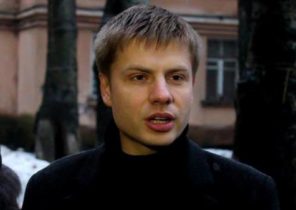May 9 in the minds of Ukrainians was fixed as the day of the parade in honor of Victory in the great Patriotic war. But this day was another parade, which I try not to remember, but which is a landmark in the history of Ukraine.
May 9 will be exactly 100 years since the joint parade of Polish troops and the army of the UNR in the center of Kiev.
This parade was for the Ukrainian people’s Republic culminating in the final attack on the Bolsheviks, which began on 25 April 1920. In the history of the USSR and the rest of the world, however, this attack was not associated with the Ukrainian factor is considered the beginning of the Soviet-Polish war — one of the main in a series of wars ravaged Europe and Asia after world.
Coronavirus communism
As soon as in November 1918 the First world war ended in Central and Eastern Europe, the middle East and North Africa, began a huge number of local conflicts. This was due to the fact that three huge empires — Russian, Austro-Hungarian and Ottoman — collapsed. But why the Polish-Soviet war of 1920 is considered to be chief among them?
The answer, of course, to be found in the October revolution of 1917. More precisely, even not in itself, and that the Bolsheviks were able to retain power during the whole of 1918 and even waited that the revolution began to turn to erupt in Germany, in Hungary, in Slovakia.
The winners of the First world — primarily Britain and France — began to treat communism as coronavirus. First they tried to send in a military expedition, but it ended up being an urgent evacuation as a “revolutionary plague” began to penetrate even in their troops.
Therefore, London and Berlin decided to fight against the “Bolshevist epidemic” by proxy. First it was the debris of old Russia in the form of armies of Admiral Kolchak, generals Denikin and Yudenich. Then the bet was made on the “anti quarantine”, which was then called “cordon Sanitaire” — a chain of Eastern European States that the West created and began to maintain that they were not allowed “Bolshevik virus” in Europe. And the main role in these quarantine activities was to play Poland.
The Jackal Of Europe
Why Poland? It is through their own activity won casting of the West. After all, what happened in the end of 1918 in Eastern Europe can be described in one word — a mess. Austria-Hungary collapsed. Russia collapsed. Germany on the verge of collapse. By themselves formed a nation-state, which either have not been on the map of Europe, or even never had: Poland, Czechoslovakia, the Ukrainian people’s Republic, West Ukrainian people’s Republic, Lithuania, Latvia, Estonia, Finland. And where are their boundaries, is unclear.
Situation tried to use many, but the poles did it better than anyone — no wonder their country was then called “the Jackal of Europe.” They started a war against ZUNR because ZUNR tried to keep lions, where rose Polish uprising. They were border conflicts over disputed territory with the Germans and the Czechs. And also with the Bolsheviks.
Contrary to popular opinion, Poland seized Vilnius (then Vilna), not independent Lithuania, and the Lithuanian Soviet Republic, that is, in fact — the Soviet Russia. So the war with the Bolsheviks Warsaw beginning in January 1919. And then there is a gradual movement of the poles into the territory of the former Russian Empire continued for another few months — to the point that in August, 1919 they went to Minsk.
Stopped by the Polish army… the allies. The West at that time relied on the Russian White movement, therefore, supported the indignation of the government of the South of Russian occupation of Poland napolskih territories. In 1919, under the Versailles Treaty, Britain, France and their allies have set the boundaries of Poland, and East had to pass the line which later became known as the “Curzon line” (with small deviations is the current border of Poland with Ukraine, Belarus and Lithuania).
For the poles it meant to refuse to have captured Vilna and Lvov, Brest and Minsk. Such a prospect they like it couldn’t, “the chief of the Polish state” Jozef Pilsudski went to the trick.
Collusion Warsaw and Moscow
The leader of Soviet Russia Vladimir Lenin and the leader of the Commonwealth Jozef Pilsudski had a lot in common. In 1887 took place the failed assassination attempt on the Russian Emperor Alexander III, for which he was sentenced to death of Alexander Ulyanov, Lenin’s older brother, and Bronislaw Pilsudski, the elder brother of the future Polish dictator. Ulyanov was executed, Pilsudski sentence was commuted to penal servitude on Sakhalin, where he died.
Soviet historians referred to the execution of his brother a turning point for a 17-year-old Vladimir Ulyanov — say, that’s when he said the legendary phrase “We go the other way,” meaning the establishment of the path of a revolutionary. A 19-year-old józef Pilsudski did not say anything to need it in the same case, he was exiled for five years in Irkutsk province, where he became a professional revolutionary.
In the end, the way Lenin and Pilsudski went, but they had a lot of friends in common — in particular, the Chairman of the all-Russian extraordinary Commission (Cheka) Felix Dzerzhinsky, who was formerly with Pilsudski in the same party — the Polish party of socialists.
And in the fall of 1919, when the allies put Poland a barrier between Pilsudski and Lenin, any contact with the other of the Polish socialist Julian Marchlewski.
The interests of Lenin and Pilsudski agreed: the Bolsheviks needed the truce in order to repel the offensive of Denikin on Moscow, and the poles didn’t want to help the White army, the leaders of which interfered with their plans to recreate the Polish-Lithuanian Commonwealth in the borders of 1772. As a result, in September of 1919, at the decisive moment of the offensive of the Armed forces of South Russia by the Bolsheviks, fighting in the Polish-Soviet front stopped. And in October, the Red army drove the whites back to the South.
Main medic
By the beginning of 1920, the position of the Entente has changed. They no longer hoped for a White movement in the struggle against the Bolshevik “virus” and made a bid for “sanitary cordon”. And Poland volunteered to play the role of main Bastion against Soviet Russia. However, the border along the “Curzon line” has not been canceled, but the poles were given to understand that will support them in case of aggression of the Bolsheviks. The poles hoped that in exchange for fighting with the Bolsheviks they will forgive conquest in the East.
In January 1920, Warsaw has received from the French around 1,500 instruments, 2800 machine guns, about 400 thousand rifles, about 700 aircraft, 200 armored cars, 800 trucks, 3 million sets of uniforms — so all of the white army had not received in the entire history of their struggle with the Soviets.
And by April of 1920, Pilsudski gathered 700-strong army on the demarcation line with Soviet troops (true, most of the placed to the South — in Ukraine).
Petlyura rents Galicia
April 21, 1920, four days before the start of the war, was signed the Warsaw Pact, which was signed by Pilsudski and the head of the Directory of the UNR Petliura. Under this Treaty Poland was recognized as the UNR independent state, and Petlyura agreed to give the poles Galicia with Volhynia and return to the Polish landowners of their estates in the right Bank Ukraine.
The contract was clearly unequal, but “the chieftain” UNR has no choice — by the beginning of 1920 he was already an emigrant in Poland, where he moved with the remnants of his army. Now Petlyura was a chance though somehow to restore its authority at least on a part of Ukraine.
Of course, the Warsaw Pact can be considered a betrayal of Petliura against the West Ukrainian people’s Republic, but it has in fact never existed, and the Galician part, once fought on the side of the UPR, by the time he had to war for whites and flip back to red. So from zluka not gone — more than that, in the winter of 1919/20 years there were cases when the troops of UNR fought against units of the red Ukrainian Galician army.
Just because Petliura recognised the Polish rights that already belonged to them. And Pilsudski this was the need to get from the Entente of the abolition of the “Curzon line”.
Kiev may 9 parade
On 25 April 1920 the Polish troops took the offensive on all fronts, and already on April 28 came on — line in Vinnitsa Chernobyl. However, we should not assume that in three days they passed one third of the territory of today’s Ukraine — is just the beginning of the war the line of demarcation already passed just West of Zhitomir and Vinnitsa, so the attack of the poles was not so large as it is now. The climax of it was the capture of Kiev on 7 may.
The first Polish unit appeared in the current Ukrainian capital on 6 may: it came by regular tram from Pushcha-Vodice, captured red commander and went back. No one was prosecuted because the Red army at this moment hastily left Kiev. The next day the Polish troops and the UPR army without a battle entered the city.
Equality between poles and Ukrainians, of course, was not. Starting with the fact that 700 thousand Polish troops participated in the war, had a maximum of 15 thousand troops of the UPR.
This was particularly the case during the Kiev parade on may 9, 1920. From Kiev, the future of the Soviet journalist David Zaslavsky recalled how strong an impression on the residents of the city the passage of the Polish division of several thousand troops in a new form and with new weapons from the Entente. And behind them were two hundred men of the army of the UNR — in a shabby uniform and with a crumbling machine guns. A parade commander of the 3rd Polish army, Edward rydz-rydz, neither Petlura nor Pilsudski in Kiev was not.
Give the Royal rubles!
However, all the occupation of Kiev by the poles carefully emphasized that they only provide security, but the power belongs to the Directory of the UNR.
Taking control of the city, the Polish administration has introduced only one significant change: the official exchange rate, went to the back.
Became the most expensive Polish brand, it was Ukrainian karbovanets of the times of the Hetman’s power, then the tsarist and Kerensky rubles, and the cheapest was considered the Soviet banknotes.
The course was clearly speculative, Kyiv markets it has not taken and counted everything in its hands, where the most expensive was quoted tsarist rubles, and the cheapest — Polish brand and the Ukrainian karbovanets. But the Polish soldiers came with stamps and was required to sell them all at the official exchange rate, for which the Kyiv merchants began their secret hate.
In General, General disillusionment began very quickly.
The NRA expected that the poles will go East and will take control of all of Ukraine, but the poles moved to the left Bank only in order to push the enemy back from the Dnieper river. Russian supporters of the White movement in General somehow expected that after the poles the Germans will come, and the combined armies will go to Moscow to overthrow the Bolsheviks.
But instead, Kiev inhabitants gather in the evening at Vladimir’s hill and watched the area Darnitsa is an artillery skirmish between the poles and the red army.
The poles, too, were disappointed. They were not going to go East, because Petliura promised them that with the advent of UNR troops left Bank Ukraine rise up against the Reds, but no attack happened. Moreover, in the villages right-Bank Ukraine began rebellions against the poles, who carried out the requisition, and pay for them with their brands. The villagers of the Polish currency to take not wanted and demanded of the Tsar’s roubles or “kerenki”.
But most of the poles were disappointed by the complete inability of the Directory of the UNR to establish their own government, which it would be possible to transfer power. Petlyura in mid-may briefly arrived in Kiev and went to Vinnitsa, which made the location of his government. All this created the impression of temporariness of the Polish and Ukrainian authorities in the city.
Stalin agitates for Galicia
The Bolsheviks began their offensive on may 14. It was preceded by a stormy debate in the Soviet leadership, split it into two parts.
The leader of the red army Leon Trotsky and his protege Mikhail Tukhachevsky advocated plan of attack from Belarus directly to Warsaw. They believed that the threat of the Polish capital will force the poles to withdraw from Kiev and Ukraine in General.
Against the leadership of the General staff of the red army, and led the opposition to Trotsky, Joseph Stalin. He has published in the main newspaper of Soviet Russia “Pravda” article, which explained: the attack on Warsaw will fail because, first, there is an army of Pilsudski will have a uniform Polish rear, second, the allies will be frightened of the invasion of the Bolsheviks in Europe and will support Poland. Alternatively, Stalin suggested that the attack on Kiev with a further strike through Galicia (then it was called Eastern Galicia): there are Western Ukrainians hate the poles, and therefore will support the Red army.
Lenin hesitated, and was therefore accepted in both versions: the Western front Tukhachevsky gave the command to attack from Belarus, and the South-Western front were sent to Stalin, where he could implement his plan.
Marsh Budennogo
May 14, Tukhachevskogo troops launched an offensive on Minsk, forcing the poles to pull some troops from Ukraine. Two weeks later, the offensive of the Western front were exhausted, but then said his word South-Western front, which was led by the front commander Alexander Egorov and member of the revolutionary military Council of Stalin.
May 26, the Red army launched an offensive on the Ukrainian territory, and the strike force of the southwestern front to get two months from the Caucasus (and on the way defeated the army of Nestor Makhno), the First Cavalry army of Semyon Budyonny.
May 27, Budyonny cavalry launched an offensive from Uman in Kazatin, and eight days later broke through the defenses of the poles and went to the rear of the Polish troops stationed in Kiev.
Already on June 6, Budennovsky took Berdichev and launched an attack on Zhitomir. Before the army, Rydz-smigly in Kiev threatened environment.
To leave and burn bridges
About the RAID Budenny press Kiev — Ukrainian “Gromadske the word” Polish “Dziennik Kijowski” wrote since the first days of June. Three times it was reported that the First Cavalry army was defeated, and once even that Budyonny had committed suicide.
But since the fall of Kiev in Berdichev began to panic.
“Thrice beaten and committed suicide Budyonny not only captured the city, but also cut off the poles all the way to the retreat” — so has described the impressions of Kiev David Zaslavsky.
From the town to the West EN masse, rushed to Kiev by the poles, the supporters of the UNR and the remnants of the supporters of the White army. Polish authorities, however, managed to stop the panic and to conduct an organized retreat.
However, this “organized retreat” Kiev remembered for a long time: before leaving the city rydz-smigly gave the command to destroy all the buildings and warehouses, where stored products, household goods and military equipment, which had not been evacuated from the city. Among the destroyed buildings was the Governor General’s house on the corner of Institute and shelkovichny — the one that was the residence of Hetman Pavlo Skoropadsky in 1918.
And the climax of the retreat on June 10 was the destruction of all the bridges in Kiev.
“Despite the danger, thousands of Kiev residents under fire were standing at Vladimirskaya Gorka, and many with tears looked at the loss of the Chain and the railway bridge. The light was yellow in the daylight, calm the fire all four bridges. And was seen far and wide, as fell into the water flooring, and hanging on to the bulls in a chain of a handsome Chain bridge, the pride and decoration of Kiev, recalled Zaslavsky. It street, which would not be traces of a military and revolutionary storms. But never been in Kiev, the destruction that would be done with such a cold and cruel indifference. None of that passed through Kiev armies did not encroach on the bridges. And at the sight of the destroyed bridges, to restore it will not succeed, at the sight of the sprawling fire was born in Kiev not only a sense of anger and revenge, but the feeling of injured patriotism, of hostility towards the stranger-to the conqueror. If I won the poles, to return to Kiev, they would have could not.”
Polish flight
During the second half of June Warsaw had to transfer troops from Belarus to Ukraine to stop the offensive of the army of Budyonny. But July 4, troops of the Western front launched their offensive, and it proved disastrous for the Polish army, its retreat over the next weeks turned into a wholesale flight.
The Warsaw government, led by the famous pianist Ignacy Paderewski, and requested the assistance of the West. As predicted by Stalin, Paris and London have this appeal heard.
The French sent a military mission led by General Weygand, who will soon actually led the Polish army, and the expeditionary force. The British sent Moscow a proposal to conclude a truce, by which the state border would pass on the “Curzon line” — that is, in the Soviet Russia would have entered Western Ukraine with Lviv and Western Belarus.
The miracle on the Vistula
The General staff of the red army, in which sat the supporters of Stalin, was recommended to accept the offer. But Lenin has already caught the fever of the world revolution from Trotsky and Tukhachevsky now he demanded an attack on Warsaw and on to Berlin.
At the end of July the Bolsheviks had established the provisional Polish revolutionary Committee, which declared itself the power in Poland on 1 August, immediately after the capture of the red army Bialystok. It was headed by the same old familiar Pilsudski — Marchlewski.
By mid-August the troops of Tukhachevsky was already near Warsaw, and the troops Yegorov and Stalin — near Lviv. But here’s the difference, on which Stalin wrote in may: South-West front was on the territory where the local population hated the poles, and had established supply routes, while the Western front gets the rear, had exposed flanks, and in addition fought with the local population.
Moscow, keen plans to hike through Warsaw to Berlin, demanded from Egorov and Stalin to give the army Budennogo Tukhachevsky, but the First Horse was involved in the battles for Lviv, and Stalin did not follow the orders of the centre.
South-Western front sent the Budennovsky to the North-West, only four days, but during that time the triumph of Tukhachevsky was a disaster: strengthened reserves of the Polish army attacked the exposed flanks of his troops, and 240 thousand soldiers of the Western front was in the pot. Happened what in Poland was called “the Miracle on the Vistula”.
Almost the entire army of Tukhachevsky died either in August-September 1920 during attempts to break out of encirclement, or later in the Polish camps. Before the Polish troops, which by that time has reached millions, have empty space they could come up to Moscow, meeting no resistance. But instead they stopped.
A few weeks later, Lenin in one of his speeches acknowledged that the leaders of the RSFSR “would have been hung on the roadside trees”, if not mutual hostility of opponents.
The fact that I was fighting in the South of Ukraine, where red fought with the troops of Baron Wrangel, replaced Denikin at the head of the army of the South of Russia. And Pilsudski, apparently did not want to pull the chestnuts out of the fire to restore “United and indivisible” Russia.
October 12 the delegation of Poland and Soviet Russia signed in Riga an agreement on the ceasefire, which allowed the Bolsheviks to throw all forces on the southern front against Wrangel and to dislodge it from the Crimea.
And in March 1921 in the same Riga was signed a peace Treaty. According to it, Poland renounced its claims on Kiev and Minsk, but received the Western Ukraine and Western Belarus. With this document, the poles might go to Paris and London, saying that they saved from Sovietization in Lviv and Brest, and at the same time — and all of Europe.
The Treaty of Riga was signed by three States — Poland, the RSFSR and the Ukrainian Soviet Republic. On the Union with the UNR Pilsudski had already forgotten, and Petlyura was again the emigrant — now until the end of life.
19 years later
The Soviet-Polish war of 1920 was a landmark for both States. In the Soviet political and military leadership formed two clans that are at odds with each other over the next decades. The debate about whose plan of attack was better ended for Mikhail Tukhachevsky a bullet in the head in 1937, and Leon Trotsky — blow of an ice ax in 1940.
By the time Stalin had already decided the Polish question in its own way, ensuring at the 1939 border along the “Curzon line” which he insisted in 1920.
On the same day, when Soviet troops crossed the Polish border, to join the lost 19 years ago the lands of Western Ukraine and Western Belarus, the leadership of the Polish state left by fleeing to Romania. Led the “Polish delegation” Supreme commander of the Polish army and de facto head of state Edward rydz-rydz. The same man who for 19 years and three months earlier fled from Kiev.







